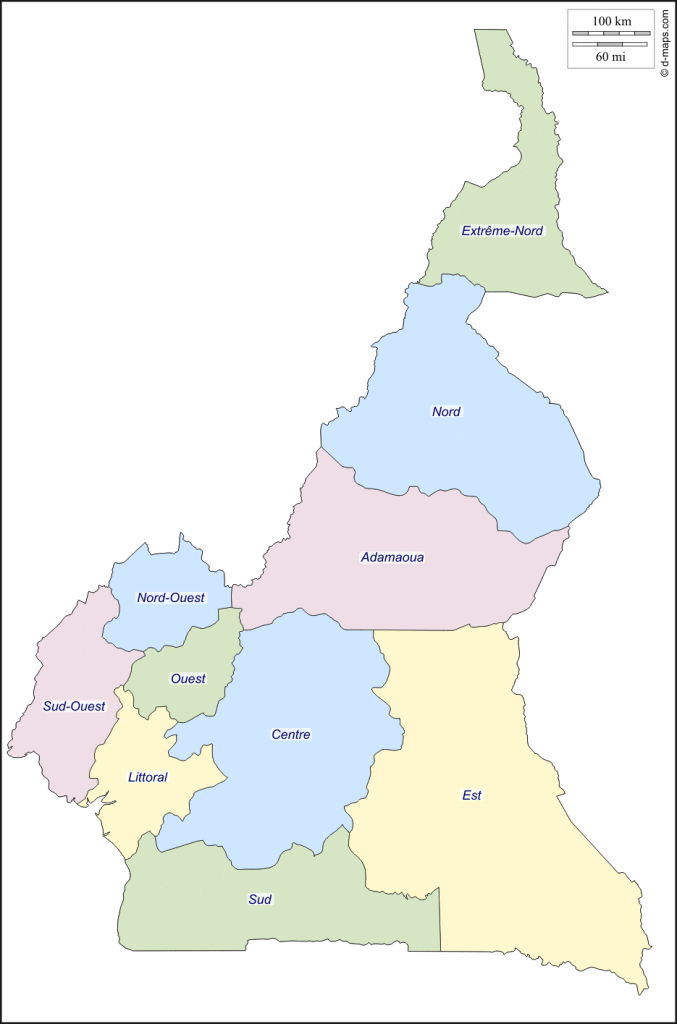Cameroon has used the same electoral system since 1992 to elect the 180 members of the National Assembly.
Allocation Method
There are a mixture of single-member (SMDs) and multimember (MMDs) districts. In each district, a party must present a list of candidates equal to the number of mandates available (e.g. one candidate in an SMD).
In SMDs, the single-member plurality system determines the winner. Put more simply, the candidate of the party with the most votes wins.
In MMDs, any list that gains a majority of the vote wins all of the seats. Otherwise, the first-place list receives one-half of the seats rounded up to the nearest whole number if necessary. The remaining seats are then distributed among the other parties that earned at least 5% of the votes cast in the constituency according to the largest remainder system of proportional representation with a Hare quota.
Additional documents, maps, and information on sources below.
Allocation Example
 This table shows the votes and allocation process in 1992 in Wouri, a constituency with 9 seats in Littoral Province. UPC came in first but did not win a majority, which would have qualified it to receive all 9 seats. Instead, it received one-half of the seats rounded up, or 5 seats (9/2 = 4.5, rounded up to 5).
This table shows the votes and allocation process in 1992 in Wouri, a constituency with 9 seats in Littoral Province. UPC came in first but did not win a majority, which would have qualified it to receive all 9 seats. Instead, it received one-half of the seats rounded up, or 5 seats (9/2 = 4.5, rounded up to 5).
The remaining four seats were divided among the three other parties with more than 5% of the district vote: RDPC, UNDP and PNP. A Hare quota for these parties equals 20,350–the total votes cast for the three parties, 81,403, divided by the number of remaining seats, 4. Seats were then awarded for multiples of full Hare quotas, so RDPC and UNDP each gained one seat. The Remainder Votes column shows the votes unused by the three parties towards a full Hare quota. The remaining two seats were allotted in descending order of these remainders, so first RDPC received a seat and then UNDP gained the last seat.
Apportionment
In Cameroon, the President delimits parliamentary constituencies within provinces and can subdivide administrative districts within a province into multiple electoral districts or, more rarely, combine administrative districts into a single electoral district.


Cameroon Constitution (French)
Cameroon Constitution (English)
Cameroon Electoral Code (French)
Cameroon Electoral Code (English)
1992 NDI Cameroon Election Report
1997 IFES 1997 Cameroon Legislative Elections Report
2013 CET Cameroon Legislative and Municipal Elections Report
Map of Cameroon’s Provinces
Sources: I am grateful to Ericka Albaugh for sharing her data on apportionment and boundary delimitation in Cameroon. For more information, see Ericka A. Albaugh, “An autocrat’s toolkit: adaptation and manipulation in ‘democratic’ Cameroon,” Democratization 18: 2(2011), 288-414; Andreas Mehler, “Cameroon” in Dieter Nohlen, Michael Krennerich and Bernhard Thibaut, eds., Elections in Africa (Oxford 1999), 167-88; Electoral Code (see above); Elections Cameroon.

